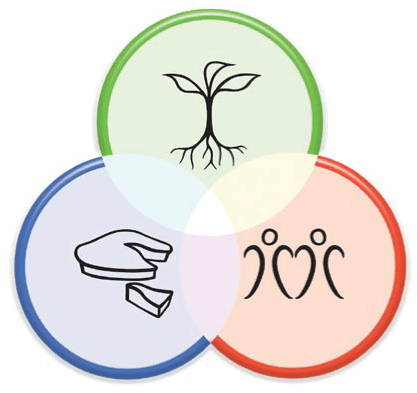A Few Thoughts on "Permaculturizing" Our Economy
-By Lucie Bardos
 |
| The three Permaculture ethics are Care for the Earth, Care for People, and Fair Share (giving something back) |
More and more people are becoming aware of the fact that large-scale monocrop based agriculture depletes soil, damages natural ecosystems, and produces nutrient deficient produce, among other unpleasant things. An alternative to this system, synthesized by Bill Mollison and David Holmgren in Australia during the 70's and 80's, is called Permaculture. Permaculture mainly involves modeling human-friendly horticultural systems on naturally occurring ecosystems that cycle energy and nutrients within themselves in a self-perpetuating way. This method eliminates the need for chemical pesticides, herbicides and fertilizers and creates maximum yield per minimum amount of human work.
Permaculture initially stood for "permanent agriculture" because Permaculture systems are able to exist for extended periods of time, and produce food and other essential services for human and non-human life. However, it was soon discovered that the Permaculture model could be applied not only to growing plants, but also to everything from building houses and other structures, to organizing community events, economics and even daily routine activities. It therefore came to stand for "permanent culture" and is viewed by many as a general model for all facets of sustainable living.
One component of rethinking our current economic system is the creation of community currencies. Money has come a long way since the creation of commodity currencies that were traded as unit amounts of grains, produce or livestock, to something much more elusive and intangible, something that none of us ever seem to have enough of and that all too easily slips from our fingers into the hands of the banks and credit card companies. Community currencies aim to put the original value and meaning behind money back on the table in a manner that evokes many of the same principles that inform Permaculture.
 |
| Permaculture teacher Delvin Solkinson uses Seedstock Community Currency to purchase a book at Homesteader's Emporium. |
In a similar way, humans can harness the energy of community currencies to do beneficial work within a community. Seedstock Community Currency in Vancouver, for example, can be used by the public in exchange for the goods and services offered by local businesses, or it can be used by the businesses themselves for this purpose. It can be traded for Canadian dollars in fundraising initiatives by non-profits or it can be used to create interest-free microloans for urban farmers who are willing to accept it as partial payment for their produce. It creates publicity for local businesses and organizations, while strengthening ties between the two through gifting, and creating a stronger bond between community residents and their local businesses and organizations. These bonds create a trusting community environment and stimulate communication and cooperation, which tends to generate things like happiness and stability. They can be compared to the long-lasting bonds that exist in a well-designed Permaculture garden. People make the money work for them and keep it circulating through the system (system) as it helps make the system more resilient, stable and healthy.
So “permaculturizing” our economy might be one of the steps that we can take towards a more sustainable and socially responsible future. If we can cycle energy and grow healthy food systems in our back yards, why not use the same principles to grow healthy money systems in our communities?
